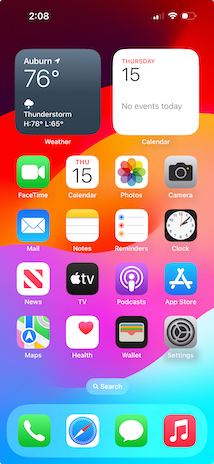
The iPod Nano is a discontinued portable media player designed and formerly marketed by Apple Inc. The first-generation model was introduced on September 7, 2005, as a replacement for the iPod Mini, using flash memory for storage. The iPod Nano went through several models, or generations, after its introduction. Apple discontinued the iPod Nano on July 27, 2017.

Apple TV is a digital media player and microconsole developed and marketed by Apple. It is a small piece of networking hardware that sends received media data such as video and audio to a TV or external display. Its media services include streaming media, TV Everywhere-based services, local media sources, and sports journalism and broadcasts.
The iPhone is a line of smartphones produced by Apple that use Apple's own iOS mobile operating system. The first-generation iPhone was announced by then–Apple CEO Steve Jobs on January 9, 2007. Since then, Apple has annually released new iPhone models and iOS updates. As of November 1, 2018, more than 2.2 billion iPhones had been sold.

iOS is a mobile operating system developed by Apple Inc. exclusively for its smartphones. It was unveiled in January 2007 for the first-generation iPhone, launched in June 2007.

The iPhone 3G is a smartphone designed, developed, and marketed by Apple Inc. It is the second generation of iPhone, successor to the original iPhone, and was introduced on June 9, 2008, at the WWDC 2008 which took place at the Moscone Center in San Francisco.
iOS jailbreaking is the use of a privilege escalation exploit to remove software restrictions imposed by Apple on devices running iOS and iOS-based operating systems. It is typically done through a series of kernel patches. A jailbroken device typically permits root access within the operating system and provides the right to install software unavailable through the App Store. Different devices and versions are exploited with a variety of tools. Apple views jailbreaking as a violation of the end-user license agreement and strongly cautions device owners not to try to achieve root access through the exploitation of vulnerabilities.

The iPhone is the first iPhone model and the first smartphone designed, developed, and marketed by Apple Inc. After years of rumors and speculation, it was officially announced on January 9, 2007, and was released in the United States on June 29, 2007.

The iPhone 5 is a smartphone that was designed, developed, and marketed by Apple Inc. It is the 6th generation iPhone, succeeding both the iPhone 4 and iPhone 4S, and preceding both the iPhone 5S and 5C. It was formally unveiled as part of a press event on September 12, 2012, and subsequently released on September 21, 2012. The iPhone 5 was the first iPhone to be announced in September, and setting a trend for subsequent iPhone releases, the first iPhone to be completely developed under the guidance of Tim Cook and the last iPhone to be overseen by Steve Jobs. The iPhone 5's design was used three times, first with the iPhone 5 itself in 2012, then with the 5S in 2013, and finally with the first-generation iPhone SE in 2016.

The iPad is a tablet computer, developed and marketed by Apple Inc. It is the third device in the iPad line of tablets. It added a Retina Display, the new Apple A5X chip with a quad-core graphics processor, a 5-megapixel camera, HD 1080p video recording, voice dictation, and support for LTE networks in North America. It shipped with iOS 5, which provides a platform for audio-visual media, including electronic books, periodicals, films, music, computer games, presentations and web browsing.
The iPad Mini is a line of small tablet computers designed, developed, and marketed by Apple Inc. It is a sub-series of the iPad line of tablets, with screen sizes of 7.9 inches and 8.3 inches. The first-generation iPad Mini was announced on October 23, 2012, and was released on November 2, 2012, in nearly all of Apple's markets. It featured similar internal specifications to the iPad 2, including its display resolution.

The iPad Mini 2 is a tablet computer produced and marketed by Apple Inc. It has a nearly identical design to its predecessor, the first-generation iPad Mini, but features internal revisions such as the use of an A7 system-on-a-chip and a 2,048 x 1,536 resolution Retina Display. Internally, the second-generation iPad Mini has nearly the same hardware as its sibling device, the iPad Air. Apple released the second-generation iPad Mini in space gray and silver colors on November 12, 2013.

The iPad Mini is the first generation, known retrospectively as the iPad Mini 1, of the mini tablet computer designed, developed, and marketed by Apple Inc. It was announced on October 23, 2012, as the fourth major product in the iPad line and the first of the iPad Mini line. It features a reduced screen size of 7.9 inches (20 cm), compared to the 9.7-inch (25 cm) display on standard iPads at that time. Its internal specifications resemble that of the iPad 2, including its display resolution.

The fifth generation iPod Touch was unveiled at Apple's media event alongside the iPhone 5 on September 12, 2012, and was released on October 11, 2012. A mobile device designed and marketed by Apple Inc. with a touchscreen-based user interface, it succeeded the 4th-generation iPod Touch. It is compatible with up to iOS 9.3.5, which was released on August 25, 2016.

iPhone OS 3 is the third major release of the iOS mobile operating system developed by Apple Inc., succeeding iPhone OS 2. It was announced on March 17, 2009, and was released on June 17, 2009. It was succeeded by iOS 4 on June 21, 2010, dropping the "iPhone OS" naming convention.

The sixth generation iPod Touch is a mobile device designed and marketed by Apple Inc. with a touchscreen-based user interface. It is the successor to the iPod Touch, becoming the first major update to the iPod lineup in more than two and a half years. It was released on the online Apple Store on July 15, 2015, along with minor upgrades to the iPod Nano and iPod Shuffle. This generation of iPod Touch was officially discontinued by Apple on May 28, 2019, with the release of its next-generation successor. It supports up to iOS 12.5.7, released on January 23, 2023.

The iPad Pro is a series of tablet computers, positioned as a premium model of Apple's iPad tablet computer. It runs iPadOS, a tablet-optimized version of the iOS operating system.

The iPhone 12 and iPhone 12 Mini are smartphones designed, developed, and marketed by Apple Inc. They are the fourteenth-generation iPhones, succeeding the iPhone 11. They were unveiled at a virtually held Apple Special Event at Apple Park in Cupertino, California, on October 13, 2020, alongside the "premium flagship" iPhone 12 Pro and iPhone 12 Pro Max and HomePod Mini. Pre-orders for the iPhone 12 started on October 16, 2020, and the phone was released in most countries on October 23, 2020, alongside the iPhone 12 Pro and fourth-generation iPad Air. Pre-orders for the iPhone 12 Mini began on November 6, 2020, and the phone was released on November 13, 2020, alongside the iPhone 12 Pro Max.

The first-generation iPod Touch, is a multi-touch mobile device designed and marketed by Apple Inc. with a touchscreen-based user interface. The first device of the iPod Touch series, it was unveiled and released at Apple's media event on September 5, 2007. It is compatible with up to iPhone OS 3.1.3 which was released on February 2, 2010.

The iPhone 12 Pro and iPhone 12 Pro Max are smartphones designed, developed, and marketed by Apple Inc. They are the flagship smartphones in the fourteenth generation of the iPhone, succeeding the iPhone 11 Pro and iPhone 11 Pro Max, respectively. They were unveiled alongside the iPhone 12 and iPhone 12 Mini at an Apple Special Event at Apple Park in Cupertino, California on October 13, 2020, with the iPhone 12 Pro being released on October 23, 2020, and the iPhone 12 Pro Max on November 13, 2020. They were discontinued on September 14, 2021, along with the iPhone XR, following the announcement of the iPhone 13 and iPhone 13 Pro.






















